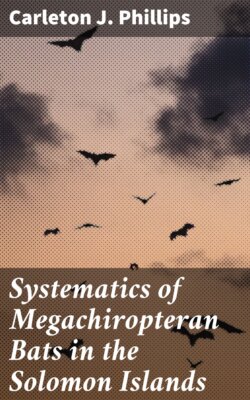Читать книгу Systematics of Megachiropteran Bats in the Solomon Islands - Carleton J. Phillips - Страница 3
INTRODUCTION
ОглавлениеThe Solomon Islands constitute an archipelago east of the large island of New Guinea and more than a thousand miles off the northeastern coast of Australia. This archipelago, which is principally of volcanic origin although sedimentary layers of calcareous rocks occur on many islands (Lever, 1934; Belkin, 1962), consists of a double chain of islands having a northwest-southeast axis of more than 600 miles. The archipelago is more or less an extension of New Guinea and in fact is connected to it in stepping-stone fashion by New Britain, New Ireland, and numerous smaller islands (see Fig. 1).
Australia and New Guinea have many kinds of mammals but the only terrestrial mammals in the Solomon Islands are a species of the genus Phalanger (order Marsupialia), and several species of four genera of rodents, one genus of which probably was introduced by man. Additionally, several kinds of bats have reached and colonized the Solomon Islands.
Fig. 1. Showing the Solomon Islands in relation to major adjacent land masses.
In the past 100 years at least 43 species and subspecies of Chiroptera of 16 genera have been recorded from the Solomon Islands; of these 27 species and subspecies of seven genera are in the suborder Megachiroptera. At least one genus of Megachiroptera is endemic as are numerous species of other genera, and subspecies of still other species.
In 1963 and 1964, the Bernice P. Bishop Museum sent several collecting parties to the British Solomon Islands Protectorate and the Australian Trust Territory of New Guinea. In the Solomons, J. Linsley Gressitt, Philip Temple, Peter Shanahan, and Ray Straatmann visited many of the larger and more accessible islands and collected a wealth of zoological materials. I have had the opportunity to study and report on specimens of mammals, especially bats, collected by the persons named and deposited in the Bishop Museum. This report is the third in a series on bats from the Solomons (Phillips, 1966; 1967). Other specimens, mostly obtained in 1944 by personnel of United States military units, are stored in the United States National Museum and have been available for study. Aims of the following report are to (1) identify the megachiropteran bats to species and subspecies and (2) discuss distribution of these bats in the Solomon Islands.
In all, 27 kinds (subspecies and monotypic species) of the order Megachiroptera are known from the Solomon Islands. These pertain to three subfamilies of the one family Pteropodidae.
The 43 Solomon Islands, having a total land area of more than 15,300 square miles (see Belkin, 1962:42-43), are listed in the gazetteer (see also Figure 2). Politically, all of the Solomon Islands except Buka and Bougainville, which are included in New Guinea Trust Territory under mandate to Australia, are in the British Solomon Islands Protectorate.
The Solomons are within 300 to 700 miles of the equator and have a fairly constant tropical climate, except at high elevations. The temperature varies little; monthly mean temperature is between 81° and 83° F. and at sea level ranges from about 70° to 93° F. yearly (Belkin, 1962:42).
Southeast tradewinds are relatively constant from May to October and this period, in general, is a dry season except at higher elevations on windward coasts. From December to March prevailing winds are from the north and precipitation throughout the island group is especially heavy. Rainfall on the island of Tulagi averages about 120 inches per year (Bryan, Edwin H., 1941; MS, p. 2, at Pacific Sci. Information Center, Bishop Museum) and up to 300 inches have been recorded on the north coast of Guadalcanal (Belkin, 1962:42-43). Occasional dry periods occur even in the period of December to March.
Most islands of the Solomon Group support dense tropical rain forest. Much of it has been modified by man. Some clearings and scattered coconut plantations are found along coasts. On some of the larger islands (for example, Guadalcanal) coastal scrub (especially on leeward coasts) and extensive grassy areas are to be found. Additional notes on vegetation are in the gazetteer.
The 165,000 persons living on the Solomon Islands are mostly Melanesians but some are mixed Papuan, Malay, and Polynesian. These native peoples are notorious for their cannibalistic tendencies; the eating of human flesh usually was related to warfare, although malefactors and human sacrifices accounted for some of the cannibalism (Cranstone, 1961:29). Prior to the Second World War few Europeans visited the Solomons and several islands still remain beyond reach of modern-day technology. For example, Rennell and Bellona islands, south of the main part of the archipelago, are visited only rarely, and then only by a medical officer or the Resident Commissioner. According to Troughton (1936:341), the islanders in the interior of Bougainville as late as 1935, were prone to kill and feast upon strangers. In 1932, Lewis (1951:37) felt that the natives of Malaita Island were especially resistant to outside interference by Caucasians and reported that no "white man or foreigner" was safe on Malaita.
Troughton (1936), who listed Melanesian names for mammals, indicated that the native peoples distinguished between kinds of bats that closely resembled one another. Of these, the only bats that seem to be used as food belong to the genus Pteropus.
